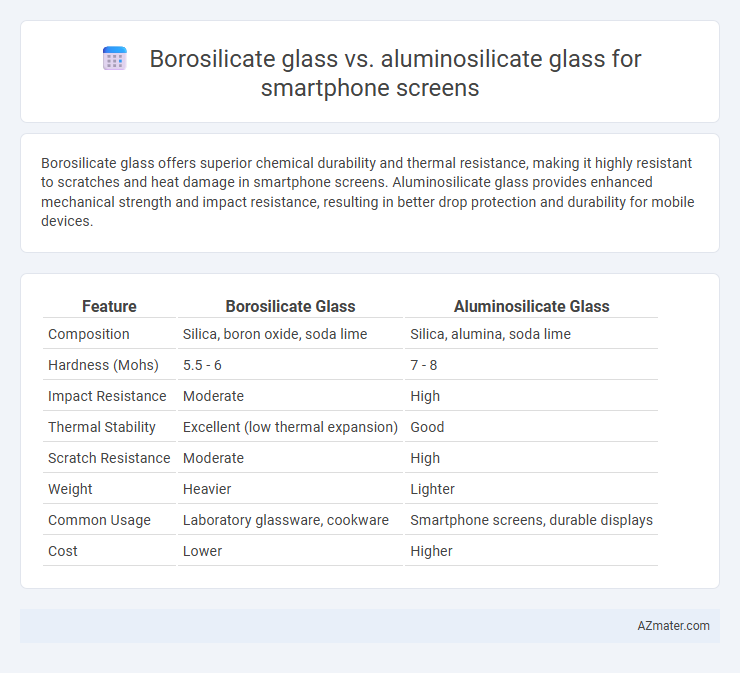Borosilicate glass offers superior chemical durability and thermal resistance, making it highly resistant to scratches and heat damage in smartphone screens. Aluminosilicate glass provides enhanced mechanical strength and impact resistance, resulting in better drop protection and durability for mobile devices.
Table of Comparison
| Feature | Borosilicate Glass | Aluminosilicate Glass |
|---|---|---|
| Composition | Silica, boron oxide, soda lime | Silica, alumina, soda lime |
| Hardness (Mohs) | 5.5 - 6 | 7 - 8 |
| Impact Resistance | Moderate | High |
| Thermal Stability | Excellent (low thermal expansion) | Good |
| Scratch Resistance | Moderate | High |
| Weight | Heavier | Lighter |
| Common Usage | Laboratory glassware, cookware | Smartphone screens, durable displays |
| Cost | Lower | Higher |
Introduction: The Rise of Advanced Glass in Smartphones
Borosilicate glass offers excellent thermal resistance and chemical stability, making it a popular choice in early smartphone screen technology for durability and scratch resistance. Aluminosilicate glass, such as Corning Gorilla Glass, provides superior strength, impact resistance, and flexibility due to its aluminum oxide content, enhancing smartphone screen toughness against drops and scratches. The shift towards aluminosilicate glass reflects the increasing consumer demand for more resilient, thin, and lightweight displays in modern smartphones.
What is Borosilicate Glass? Key Properties
Borosilicate glass is a type of glass composed mainly of silica and boron trioxide, renowned for its exceptional thermal resistance and chemical durability. Key properties include high resistance to thermal shock, low thermal expansion coefficient, and excellent mechanical strength, making it suitable for environments requiring durability and stability under temperature fluctuations. Its clarity and scratch resistance are enhanced compared to standard glass, although it tends to be heavier and less impact-resistant than aluminosilicate glass commonly used in smartphone screens.
Aluminosilicate Glass Explained: Composition and Features
Aluminosilicate glass, composed primarily of silica, alumina, and alkali metal oxides, offers superior scratch resistance and enhanced toughness compared to traditional borosilicate glass, making it ideal for smartphone screens. Its unique molecular structure allows for increased durability and impact resistance, reducing the likelihood of cracks and chips during daily use. This glass also exhibits excellent thermal stability and chemical resistance, ensuring long-lasting clarity and performance under various environmental conditions.
Comparative Strength and Durability
Borosilicate glass offers excellent thermal resistance and chemical stability but has lower impact strength compared to aluminosilicate glass, which is engineered for higher mechanical toughness and enhanced scratch resistance, making it ideal for smartphone screens. Aluminosilicate glass, such as Gorilla Glass, incorporates aluminum oxide to improve hardness and durability, providing superior protection against drops and abrasions. The increased ion-exchange process in aluminosilicate glass further strengthens the surface, resulting in better long-term durability compared to borosilicate alternatives.
Scratch and Impact Resistance: Which Performs Better?
Borosilicate glass offers excellent thermal stability and chemical resistance but typically falls short in impact resistance compared to aluminosilicate glass used in smartphone screens. Aluminosilicate glass, particularly chemically strengthened types like Gorilla Glass, provides superior scratch resistance and impact durability due to its enhanced surface compressive stress and higher fracture toughness. In real-world smartphone usage, aluminosilicate glass consistently outperforms borosilicate glass by delivering greater protection against drops and scratches.
Clarity and Display Quality Differences
Borosilicate glass offers excellent optical clarity with minimal distortion, making it suitable for high-resolution smartphone displays requiring sharp image quality. Aluminosilicate glass, popular in devices like Gorilla Glass, provides superior hardness and scratch resistance while maintaining high transparency and color accuracy. Differences in display quality mainly arise from aluminosilicate's enhanced toughness, which protects the screen without compromising visual sharpness or brightness.
Thermal Stability: High-Temperature Performance
Borosilicate glass offers superior thermal stability with a high softening point around 820degC, enabling better resistance to deformation under high temperatures compared to aluminosilicate glass, which typically softens between 1000degC and 1200degC but may exhibit less thermal shock resistance. Aluminosilicate glass, incorporated with aluminum oxide, provides enhanced mechanical strength and scratch resistance but can be more vulnerable to sudden thermal changes than borosilicate glass. For smartphone screens requiring sustained high-temperature performance and durability, borosilicate glass remains a preferred choice in applications demanding thermal stability and resistance to thermal stress.
Cost and Manufacturability for Smartphone Screens
Borosilicate glass offers lower raw material costs and easier manufacturability compared to aluminosilicate glass, making it a budget-friendly choice for smartphone screens. Aluminosilicate glass provides superior strength and scratch resistance but involves higher production complexity and cost due to advanced ion-exchange processes. Manufacturers weigh cost-efficiency against durability requirements when choosing between these two glass types for smartphone display applications.
Environmental Impact and Recycling Considerations
Borosilicate glass offers superior chemical durability and thermal resistance, leading to longer screen lifespan and reduced environmental waste for smartphones. Aluminosilicate glass, commonly used in smartphone screens, provides high strength and scratch resistance but presents more challenges in recycling due to its complex composition and energy-intensive processing. Choosing borosilicate glass can enhance recyclability and minimize ecological footprint, whereas aluminosilicate glass demands advanced recycling technologies to mitigate environmental impact effectively.
Conclusion: Choosing the Right Glass for Smartphone Screens
Borosilicate glass offers excellent thermal resistance and chemical durability, making it ideal for environments with high temperature fluctuations. Aluminosilicate glass provides superior scratch resistance and toughness, which enhances everyday durability and impact protection in smartphones. For smartphone screens, aluminosilicate glass is generally preferred due to its balance of hardness and resilience, delivering better long-term performance and user experience.

Infographic: Borosilicate glass vs Aluminosilicate glass for Smartphone screen
 azmater.com
azmater.com